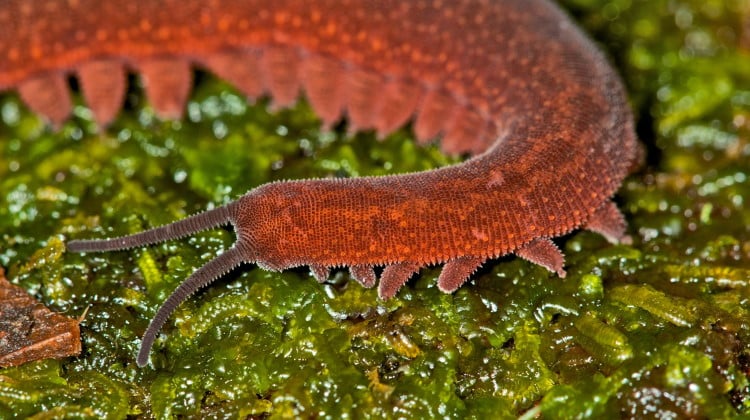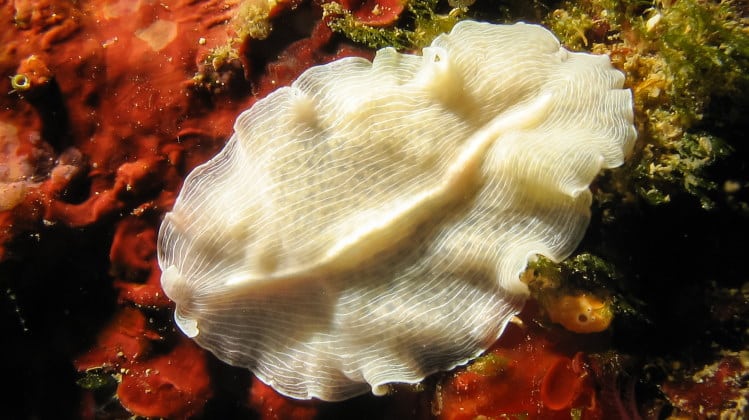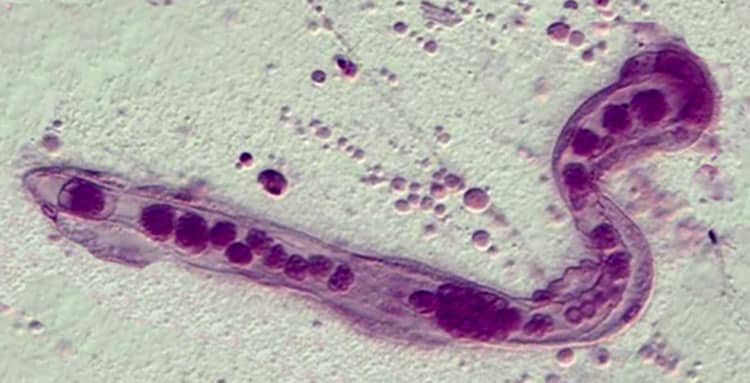Are Velvet Worms Dangerous?
Velvet worms have a gentle name and disposition – moving tenderly on their chubby legs and carefully examining the world with their rounded, smooth antennae. Yep, Onychophorans seem like toy-like creatures – until you see them in action.
Are Velvet Worms Dangerous?
Although their common name is related to their soft texture, the Latin name Onychophora means “claw bearer.” However, the claws on each leg stub are not a threatening weapon – they help the velvet worm cling to surfaces, ensuring a firm grip.
And why would these elongated invertebrates need a firm grip on things? It’s because they’re fierce hemolymph-thirsty predators, comparable to centipedes in terms of hunting skill and appetite.
However, centipedes rely on their speed and strength to subdue their prey. The slower velvets have another trick up their sleeves – or, more precisely, slime up their glands.
The tale of an average Onychophoran hunt is a perfect Halloween story candidate.
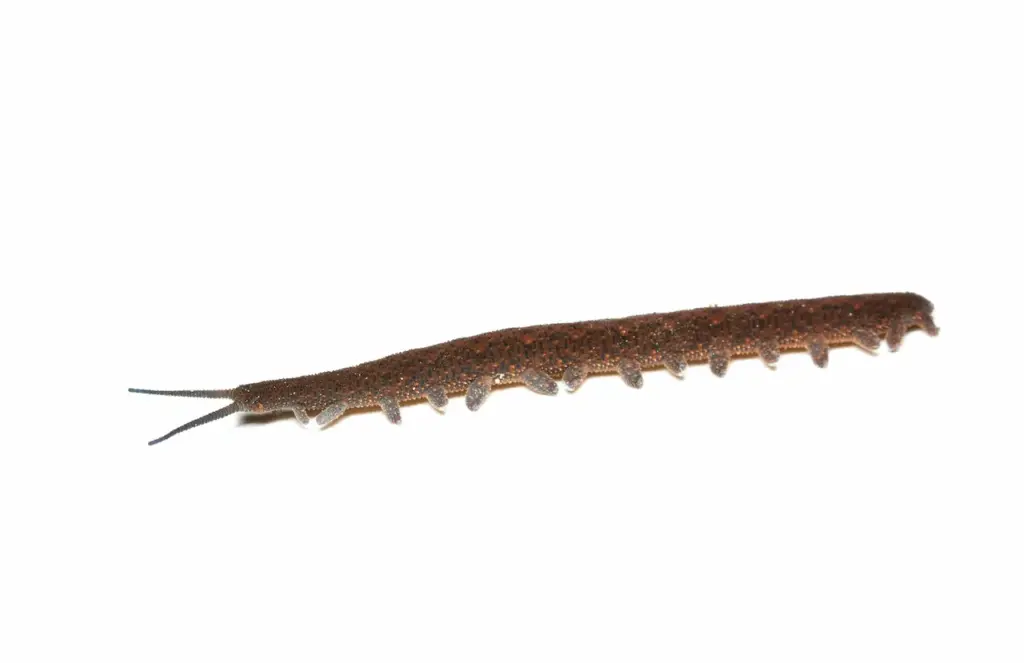
After sneaking up through the darkness on the unsuspecting prey, the velvet worm will shoot an incredibly sticky goo all over their future meal with stunning precision and wait until it hardens – like glue.
Now’s the really gruesome part – they move in, slice their trapped prey slightly open with their lacerating jaws, and inject their digestive fluids. The prey liquifies on the inside, and the hungry velvet worm sucks out this insect soup – after eating its hardened slime.
Certainly, velvet worms are perfectly adapted to their predatory role – so well that some sources call them the big cats of the undergrowth. If you were the velvet’s potential prey, I’d tell you to run away with no hesitation.
Now that was a no-brainer, but what about larger creatures? Sure, velvet worms are small, but there was the shooting adhesive slime, the slicing jaws, the liquifying fluid, the claws. Could they hurt larger creatures? Do velvet worms pose any danger to humans? Can they harm our pets?
Can Velvet Worms Kill?
Velvet worms kill for a living – but only creatures smaller than themselves. The Onychophoran diet consists of insects, isopods, slugs, and occasional fellow predators such as spiders and centipedes.
Are Velvet Worms Dangerous To Humans?
Despite their fierce “worm-like big cat” reputation, the answer is no – velvet worms do not attack humans, nor they’re known to harm us in any way. In fact, they can be handled gently and might curl into a ball or a spiral if scared (heart-melting, right?).
Still, why wouldn’t a velvet worm at least give it a (slimy) shot – try to attack a human of unclear intentions when it has such an arsenal of invertebrate weapons at its disposal?
In reality, velvet worms are very reluctant to use their slime in general. It’s not just the humans – they will withhold from spraying even when hunting if they asses they can subdue the much-smaller prey without it. Also, they won’t spray if a threat is so big that spraying doesn’t seem to make sense.
Onycophorans are so economical with their slime because it is replenished slowly – it takes about three weeks for the velvet worm to fill its “slime tank” – repository, which is quite a long time.
Without its slime, the velvet worm cannot hunt effectively and cannot defend itself either. In some observed cases of spider predation, the Onycophoran prey seemingly could not shoot the goo in defense. Thus, since having slime ready to shoot can be a matter of life and death, it is clear why the only slime shooters in the animal world use it so carefully.
Of course, even the most patient velvet worms have their tipping point. Scientists regularly provoke the velvet worms to shoot slime in lab conditions by tickling them with a fine brush.
Are Velvet Worms Poisonous?
Velvet worms aren’t poisonous to eat – they’re consumed by predators across the animal kingdom – invertebrates, reptiles, birds, and mammals – with no practical consequences for those who caught themselves a velvety snack.
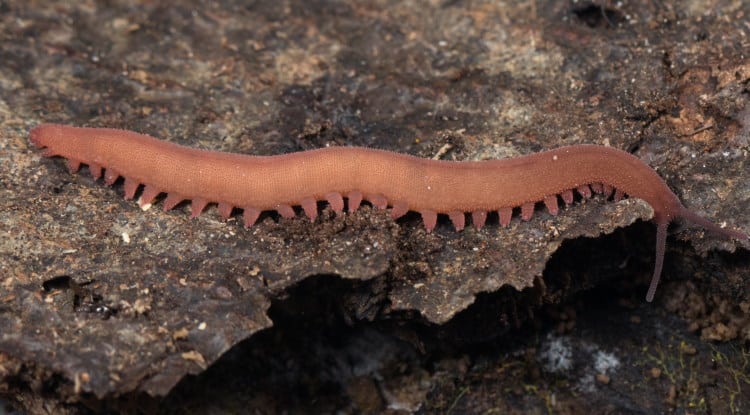
When talking about their bite, velvet worms aren’t venomous either. However, the saliva they inject into their prey has pre-digestion enzymes, which brings to mind the hunting strategies of some venomous snakes.
Can Velvet Worm Hurt a Human (at least)?
Human encounters with velvet worms are so rare that there are not many records of velvet worm bites (if any). Still, the mouthparts they use to lacerate their prey could, in theory, inflict a painful bite on a human or another larger mammal.
However, as mentioned earlier, their main defensive response when encountering a much larger creature is to curl up and not attack.
To Sum It Up
Although velvet worms are not nearly as cute and cuddly as they seem – they’re fearsome predators of other invertebrates – they pose absolutely no danger to humans, pets, or any other larger animal.
In the worst-case scenario, they may try to spray you with their glue-like slime, which has no known adverse effects on human tissue.
Still, velvet worms do have some sharp mouth parts that could inflict a painful bite. As a precaution – if you ever get to handle one of these weird little fellows – handle it with care.
Resources
- 10 Weird Facts About The Incredible Velvet Worm. (2015, C.M. Stephens, Listverse)
- How the Velvet Worm Pulls Off Its Bizarre Slime Attack. (2015, M. Woo, Wired)
- Feeding behavior of Costa Rican velvet worms: food hiding, parental feeding investment, and ontogenetic diet shift (Onychophora: Peripatidae) (2019. J.P. Barquero-González et al., UNED Research Journal)
- Velvet worm. (Australian Museum)
- Watch: Bizarre Velvet Worms Shoot Slime Jets—Now We Know How. (2015, M. Bates, National Geographic)



